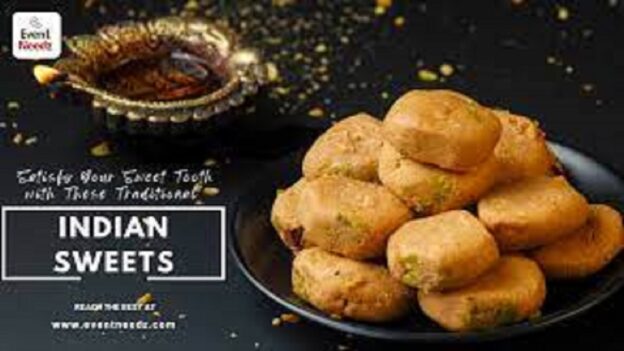A Glimpse into the World of Indian Sweets
Sweetness Woven into History
Indian sweets, often referred to as “Mithai” in Hindi, are much more than sugary treats; they are an integral part of India’s culinary heritage and cultural identity. These delectable confections have a history deeply intertwined with the traditions, festivals, and everyday life of the Indian subcontinent.
An Ancient Tradition
The origins of Indian sweets can be traced back to ancient times. Historical records, including scriptures and texts, highlight the presence of sweets in religious offerings and festive celebrations. Sweet preparations were created using ingredients such as milk, honey, fruits, and grains. These early sweets were not only enjoyed for their taste but were also offered to deities as a sign of devotion.
Culinary Artistry
Indian sweets are a testament to the culinary artistry that has evolved over centuries. Each region of India boasts its own distinctive sweets, often shaped by local ingredients and cultural influences. Whether it’s the succulent Rasgulla of West Bengal or the fragrant Mysore Pak of Karnataka, each sweet has a story to tell, reflecting the flavors and traditions of its origin.
Celebrations and Symbolism

Indian sweets are more than just culinary delights; they hold deep cultural significance. They are an integral part of celebrations and rituals, acting as a symbol of joy, happiness, and togetherness. Festivals like Diwali, Eid, and Holi are incomplete without a variety of sweets adorning the dining table. The act of sharing and savoring these treats brings people closer, fostering a sense of community and camaraderie.
Diverse Flavors and Textures
The world of Indian sweets is a treasure trove of diverse flavors and textures. From syrup-soaked delights that melt in your mouth to rich and nutty confections that offer a satisfying crunch, there is something to cater to every palate. The intricate balance of ingredients and spices creates a symphony of taste that tantalizes the senses.
A Modern Twist
While traditional recipes remain cherished, Indian sweets have also embraced modern influences. Contemporary chefs and home cooks are experimenting with new ingredients, presentation styles, and fusion flavors. This fusion of tradition and innovation has given rise to hybrid sweets that bridge the gap between the past and the present, appealing to a wider audience.
The Making and Enjoyment of Indian Sweets
Crafted with Tradition and Care
The process of creating Indian sweets is an art that requires a delicate balance of technique, tradition, and passion. Each sweet is crafted with meticulous care, using time-honored methods that have been passed down through generations.
The Essence of Ingredients

Central to the creation of Indian sweets are the ingredients that define their flavors and textures. Milk, a staple ingredient, is often transformed into khoya (reduced milk), paneer (cottage cheese), and ghee (clarified butter) to form the base of many sweets. A medley of nuts, including almonds, pistachios, and cashews, are finely ground or used as garnishes, adding both richness and visual appeal.
A Symphony of Spices
Indian sweets are elevated by the use of aromatic spices that infuse them with distinctive flavors. Cardamom, saffron, rosewater, and even delicate strands of silver or gold are used to enhance the sensory experience. These spices not only contribute to the taste but also add a touch of luxury to the sweets, making them suitable for special occasions and celebrations.
Traditional Techniques
The art of making Indian sweets is a labor of love that demands precision and expertise. Traditional methods involve simmering milk for hours to create khoya, which forms the base of many sweets. Sugar is skillfully added to create the desired consistency and sweetness. The mixture is then shaped, molded, or cooked further to achieve the desired texture, whether it’s the softness of a Gulab Jamun or the grainy bite of a Besan Ladoo.
Celebrating with Sweets
The enjoyment of Indian sweets goes beyond taste; it’s a multisensory experience that involves sight, touch, and aroma. Elaborate boxes of assorted sweets are often exchanged during festivals and special occasions. These boxes, adorned with intricate designs and colors, add an element of festivity to the act of giving and receiving sweets.
Modern Innovations

While traditional recipes hold their charm, contemporary twists on Indian sweets are emerging in response to evolving palates and culinary trends. Chefs are experimenting with creative presentations, combining unexpected flavors, and incorporating international ingredients to give classic sweets a modern makeover. These innovative variations cater to a diverse range of tastes and preferences.
Preserving Tradition Through Taste
The act of enjoying Indian sweets transcends generations. Grandmothers pass down cherished recipes to their grandchildren, ensuring that the tradition lives on. The process of making sweets becomes a shared experience, fostering a sense of family and continuity.
Conclusion
As we conclude this section, we’ve explored the intricate artistry that goes into creating Indian sweets. The careful selection of ingredients, the skillful execution of techniques, and the incorporation of cultural traditions all contribute to the creation of these delectable confections. The enjoyment of Indian sweets is a celebration of both taste and tradition, and it’s a testament to the enduring role they play in India’s culinary landscape. In the final section, we’ll reflect on the timeless joy of indulging in these sweet creations and the connections they forge across cultures and generations.

